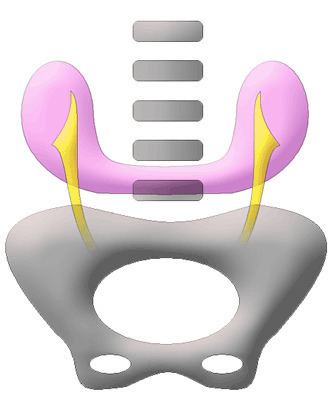Specialty medical genetics ICD-9-CM 753.3 | ICD-10 Q63.1 DiseasesDB 6020 | |
 | ||
eMedicine article/441510 article/378396 | ||
Horseshoe kidney, also known as ren arcuatus (in Latin), renal fusion or super kidney, is a congenital disorder affecting about 1 in 600 people, more common in men.
Contents
In this disorder, the patient's kidneys fuse together to form a horseshoe-shape during development in the womb. The fused part is the isthmus of the horseshoe kidney.
Fusion abnormalities of the kidney can be categorized into two groups: horseshoe kidney and crossed fused ectopia. The 'horseshoe kidney' is the most common renal fusion anomaly.
Signs and symptoms
In patients with this condition, the central portion of the kidney may be found just inferior to the inferior mesenteric artery because the normal embryologic ascent of the kidneys is arrested by its presence in people with central fusion of the kidneys. Horseshoe kidney is often asymptomatic, though persons affected by this condition may experience nausea, abdominal discomfort, kidney stones and urinary tract infections at greater frequency than those without renal fusion. There is currently no treatment for renal fusion other than symptomatic treatment.
Imaging Findings - The 2 kidneys on opposite sides of the body with the lower poles fused in midline. Midline or symmetrical fusion (90% of cases). May be missed on US, therefore pay careful attention to identification of lower poles of kidneys. Renal long axis medially orientated, Lower poles with curved configuration, elongation and poorly defined Isthmus crosses midline anterior to spine and great vessels. US for diagnosis in utero IVP followed by CT or scintigraphy for pre-operative assessment
Variant arterial supply - Bilateral renal arteries, Inferior mesenteric Artery, Arteries arising from aorta or common iliac, internal iliac, external iliac or inferior mesenteric arteries.
The lower poles of these kidneys fuse in the midline anterior to the aorta and spine. The isthmus is usually located at L4/5 level between the aorta and IMA.
Nuclear medicine (DMSA) scan confirms horseshoe kidney with fusion of both renal lower poles.
Associated conditions
While most cases of horseshoe kidneys are asymptomatic and discovered upon autopsy, the condition may increase the risk for:
The prevalence of horseshoe kidneys in females with Turner Syndrome is about 15%.
It can be associated with trisomy 18.
It can be associated with venous anomalies like left sided IVC 9.
